FRED
BOLARINWA

Pomona College
Community Engagement Center (PCCEC) Space Design
Duration: 8 weeks
Tools: Photoshop, Figma, Mural, Whiteboard
Team: Product Designers
Introduction: The Pomona College Community Engagement Center (PCCEC) is a newly instituted space in Pomona, California created to be a place where Pomona College can give back to the city. It serves as an open and inclusive space where educational programs, college application help, community outreach, and artistic events take place.
How you will be evaluated:
Spatial awareness, Experience Design, Interaction Design, Storytelling
Scope: Draw in the city of Pomona. Figure out what they need and how to best utilize the space. Create an experience.
Task:
To help the PCCEC find better ways to utilize their space, especially based on community member needs
Outcome:
A fully designed study space to be implemented this summer
My Design Process
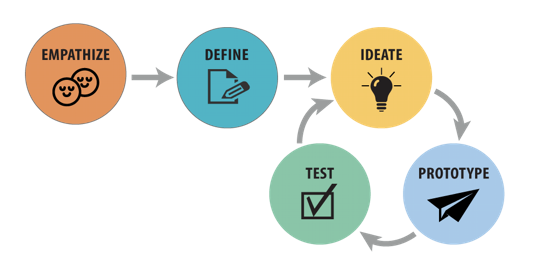

To better understand how the community center could meaningfully contribute to the Pomona community, we started researching cultural and community centers already functioning within Pomona.
This would give us integral knowledge of how Pomona residents interact with spaces and programs, as well as give us a better understanding of the dynamics with Pomona resources.
Analogous Research
We researched and explored community hotspots such as: the Lopez Urban Farm, Gente Community Garden, and the Pomona Arts District (the area where the PCCEC is located at).
Our main takeaway is that there is a heavy presence and emphasis on working with younger generations.
This was an interesting observation, one that we would begin to expand on after interviews.
✨Framework Central!✨
Knowing that art is an important part of the PCCEC and the city, we decided to use AEIOU framework while walking around the Pomona Arts District.

Background Research
The land of Pomona was vast and very different to someone from the literal other side of the country (Delaware). I knew I had some exploring to do behind the history of Pomona.

From there we decided to go just a littlleeeee bit more in depth!
UX RESEARCH METHOD 01: INTERVIEWING
We decided to conduct interviews to get more information about the real people in the city.
Our interviews ranged from teachers to college students, to artists, to cultural space owners, to non-profit leaders.
Our main takeaways were
-
Leave the space for community members of Pomona to lead.
-
The city can be apathetic and vacant except for Second Saturday
-
Literacy programs for children and adults are needed
-
Children need things to look forward to in an organized space
-
Community members are driven about their passions, but sometimes move on quickly
-
Visually exposing people to initiatives can be the most impactful
-
Pomona’s leadership can be slow and bureaucratic
-
Downtown has become very catered to youth, exclusive to elderly artists

DEFINE
To dive deeper into our interviews, we used empathy maps to understand our users.
We used multiple models to invoke raw feelings and capture the real responses of Hispanic/Latinx people
We started to see more correlation between interviews in the realm of providing programming, and adequate work/study space, especially for students. Like a good investigator, we used a few different frameworks to draw connections between interviews.

We also used 2x2 maps to see what ideas of a welcoming space we could generate from the problems we observed.


We also used the says thinks do feels framework to find out what our users would want in a space from their own words.

Background Research
From these frameworks, we were able to come up with 3 POV’s
1. High school student getting ready for college need spaces away from home that help support performance in their studies.
2. Experienced Pomona community member who wants to see structured programs for youth to develop their academic/literacy skills.
3. Young artists need stability in their careers and more validation for their art creation from the Pomona Community
Ideation
With these three POV’s in mind, we began to use various ideation techniques. We created 7 “How Might We’s” to better address these POV’S. Many of our HMW’s addressed the problems of youth and families, and creating a space for rest, focus, and comfort.
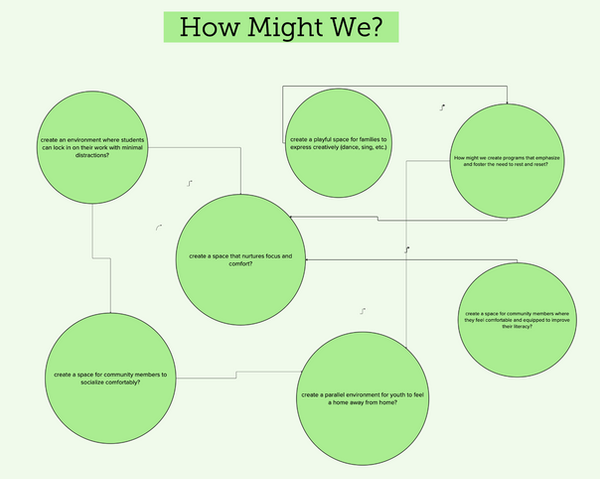
After a few sessions of ideation (100 ideas), it was clear that our first POV about high school students needing spaces away from home and school to support studies had the most potential
We were able to generate 50 ideas. By voting and filtering our ideas from low-hanging fruit, most delightful, and most groundbreaking, we noticed that there was a large gap between what was feasible/realistic and what was out of our scope.

We wanted to create something with a low risk and implementation cost, but a high impact
While pondering on how to move forward, one key moment occurred. The Hive, a creative space at Pomona College, contacted our team that they were having a high school community outreach night.
This was our opportunity.

We used an idea called moodboarding in order to take a step back from what we thought wasn’t feasible and let people express what they're looking for.


(Spanish and English writing for accessibility!)
We cut out pictures from different magazines with many different ideas expressed. The many high schoolers all had one theme in common. A study space.
Many of the elements that our participants chose surrounded intergenerational involvement, a sense of comfort, and education.
This gave us a better idea of the environment we wanted to construct that encompassed a wide variety of users.
Here is the feedback we received

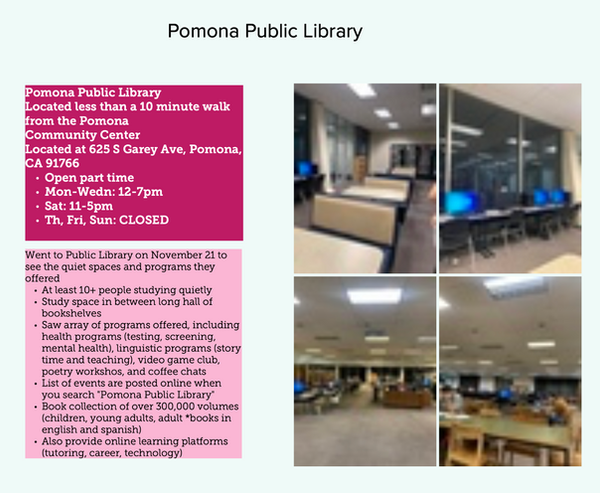
To add to our knowledge from the moodboards, we went to the Pomona Public Library to figure out what characteristics make it a good study space, and what elements made it a deterrent
Prototyping!
From the ideas we developed in the ideation phase, we came up with three possible prototypes!
-
A designated quiet space in the community center for youth to work in.
-
A networking event for youth that rotates between different industries (ex. artists, business people, engineers etc.).
-
An art gallery that requires artists to display their art and create lesson plans/activities for the youth that are aligned with the artist’s art style.
Testing Time!

For our first prototype, we created and sent out a Google form in English and Spanish, to current Pomona High students.
Questions included selection about what type of industries they would like to learn about and challenges they have faced with their career development
All nine responses on the form were positively interested in attending a career networking event, yet only five students said they would be interested in this if it was a biweekly commitment.
The most prominent challenge they faced was lack of qualification/experience.

For our second prototype, we presented high schoolers with a hypothetical scenario and had them design what their own comfortable study space would look like in this vacant room.
We observed what elements are desirable, both physically and atmospherically.
Features they wanted included warm lighting, access to 🎧, technology, and things like 🥐and 🍹.
A little cafe area and fridge would help attract students in!
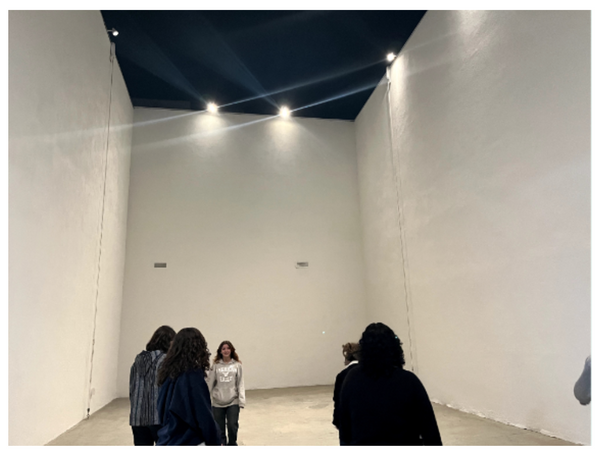
For prototype 3, we created an experience prototype for an immersive art gallery. We tested this with students who take part in the youth arts integration program.

We gave them a small drawing activity to gauge how interested they were in individual art projects while also at a professional gallery.
We observed they got distracted easily from the activity in the art gallery.
This which would in turn also aid greater awareness for that visiting artist while creating art-based projects in the center.
Although these students were interested in a gallery, they were not super interested in doing the art as well. We did ponder if this prototype would work for a different demographic, which could be figured out on Second Saturday.
Testing.... continued....
We continued with the quiet space prototype, as it was a great opportunity to implement the characteristics we found were needed for a study/educational space, in the PCCEC’s actual space.


Initial hypotheses: high school students need a space for focused work in a comfortable environment



We also decided to test a prototype with one of our interviewees.
The test was for prototype 2, the art gallery

From this test, we were able to take our reflection and iterate our prototypes.
We then began to near the end of the project.....
We decided to test out our iterated design to the PCCEC managers, by creating an experience to illuminate the problem and show our solution.
Here is our script
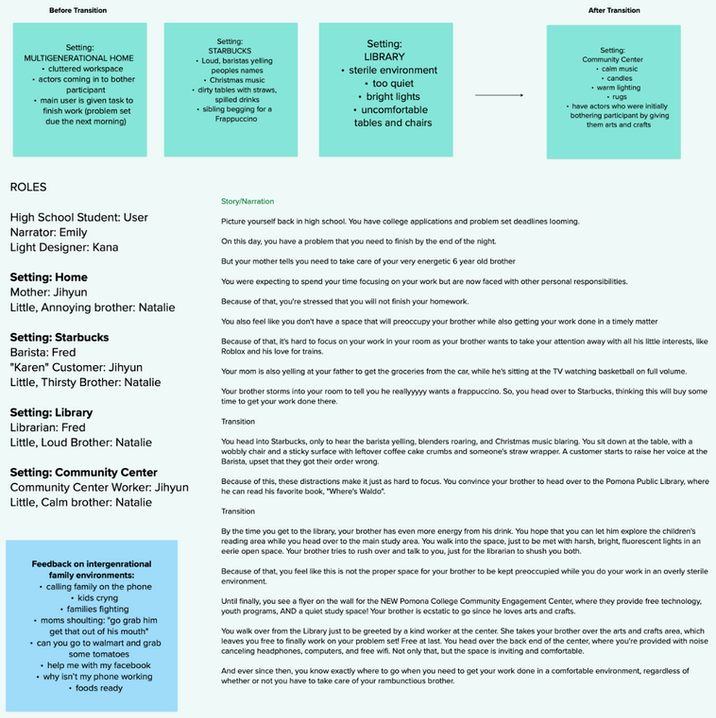

Within the quiet space, we wanted to emphasize having youth programs within it. How we perceived that would look would be a staffer accompanying the youth arts and crafts while high schools are left unadvised in the back with signs saying “Yes this is a quiet space”.
We also want to see the incorporation of access to technology, including but not limited to noise-canceling headphones, monitors, Adobe Suite, and smart/whiteboards, into a more focused and comfortable atmosphere with softer lighting, free snacks and drinks, and more comfortable chairs.

In the multi-generational home!

At Starbucks

In the Library!

In our community center quiet space!




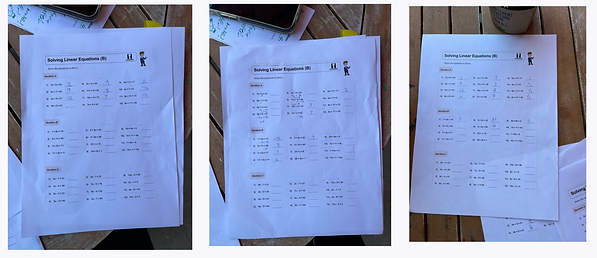
Key Learning 📚 Insight: 💡It’s important to narrow down the user. It was really important to focus on a niche user, like a high schooler with a specific need, in order to design mindfully for them. This notion of the multigenerational home was important to our final experience, in which we wanted to respect the personal responsibilities of our user without taking them away from their academic pursuits.
If I had additional time, I would…
Test more with age ranges
In regards to testing, I would have loved to test the comfortable space with more younger children in the space.
It would have been clearer to see how feasible having high schoolers and younger children in the space is.
We hope the center can experiment with this as they implement the design!
Be more intentional
I would have engaged in more intentional interviews following a first wave of random interviews. This would help with the specification of POVs to make sure we are honing in on the issues addressed from our interviewees.
My reflection...
Something new that I learned…
Sometimes the best solution is the simple solution. There’s no need to make things harder than they need to be
My biggest challenge was…
I remember being a little nervous to talk to random people when exploring places. It was hard to get out of my shell in places like Pomona’s art walk and the PCCEC art night to talk to random people about how they feel about spaces to work and study in Pomona, as well as how they feel about Pomona as a city.
Talking to my project advisor, we were gently encouraged, and I mustered the strength to overcome my nerves, and I was able to have real conversations with potential users. It was a great experience. I was able to push out of my comfort zone and learn from others. Being able to be a part of this was one of a kind, this is something I’ll forever remember.
My favorite part was…
The little random side adventures with my team that had to do with the project, like going to the library or Starbucks to get a feel for what made the environment bad for studying, it was real team bonding. Getting to know each other on a personal level while doing this work, and learning about the places around me was more than I could ask for.